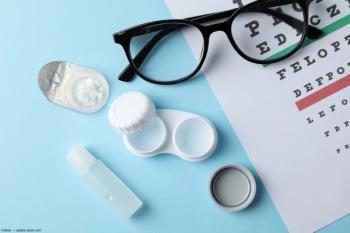
- April digital edition 2021
- Volume 13
- Issue 4
How to fit scleral lenses with confidence and caution
Closely monitor patient over time for continued corneal health and good fit
Scleral lenses have become increasingly accessible and popular and prescribed more often in recent years. Indications for these lenses include various types of ocular surface disease and irregular corneas.1 As scleral lens fitting has become more widespread over the past decade, practitioners have also come to realize different challenges and fitting limitations.2
Fitting a scleral lens is a multifaceted endeavor, with the desired outcome to improve a patient’s condition, be that improving vision or decreasing ocular discomfort. Although the benefits of scleral lens wear are clear, fitting end points may vary depending on practitioner preference and lens design utilized. Additionally, whereas some complications are relatively easy to recognize, some may fall into unclear territory.
Monocular patients
Contact lenses for monocular patients are generally avoided because of the risk of complications that could lead to vision loss in an individual with only 1 eye.3 However, in some patients with irregular corneas or dry eyes, glasses may not be an option for optimal vision correction. Specialty contact lenses, including scleral lenses, may provide significantly improved vision and comfort and can be prescribed with caution. Extra care should be taken to ensure proper lens and solution use and overall hygiene. Polycarbonate lenses in spectacles should be recommended for full-time wear with or without contact lenses, and practitioners should see patients at more frequent intervals to ensure stable eye health.
Scleral lens clearance
The concern of hypoxia in ocular structures from scleral lens wear has been discussed in the past with inconclusive evidence regarding hypoxia’s effect on the cornea. Some theoretical models suggest that certain central clearance limits must be followed for the cornea to thrive,4,5 whereas others present clinical evidence that shows no significant corneal thickness change in a clinical setting.6-8
In one paper,9 the resolution of acute, aggressive corneal neovascularization with associated haze from a previous hybrid contact lens wearer was achieved by fitting a scleral lens with central clearance in excess of 500 μm. This case demonstrates that a high central clearance itself does not automatically mean that the scleral lens fit is poor. Figure 1 and Figure 2 show a similar resolution of dense corneal haze after several years of wear. Rather, other variables should be considered as well, because all parameters of a scleral contact lens contribute to the overall system of the fit. These include the material, the diameter, and the peripheral haptic alignment of the lens.
For instance, a larger diameter may distribute the weight of the scleral lens over a larger area, resulting in less conjunctival compression, and a looser fit could indirectly decrease hypoxia by encouraging more tear exchange. In addition, careful observation must be given to scleral lens fits for corneal grafts because these postsurgical corneas may be more susceptible to endothelial and hypoxic complications. Although high clearance may not necessarily induce corneal edema, lens clearance is 1 variable that can be adjusted if hypoxia becomes a concern.
Conjunctival prolapse
Conjunctival prolapse is a clinical finding that many observe with scleral lens fits and is often more prevalent with increasing age. This occurs when loose conjunctival tissue adjacent to the limbus is pulled within the fluid chamber of the scleral lens where there is limbal clearance. The spherical optic zone of a lens on an elliptical cornea that is wider horizontally than vertically results in more limbal clearance superiorly and inferiorly.10 As such, our experience is that conjunctival prolapse appears most often in the inferior quadrant.
Conjunctival prolapse can be treated by decreasing the limbal clearance so there is limited room for the conjunctiva to migrate. This might be considered for patients with limbal stem cell deficiency or a history of inflammation because the conjunctiva may become adherent to the peripheral cornea if left untreated. In other cases, however, the prolapse may not need to be addressed.
Figure 3 shows an example of a patient with dry eye syndrome who was originally fit in 2009 with scleral lenses. The conjunctiva that is pulled into the fluid chamber returns to its normal configuration upon lens removal. Photos of both eyes 10 years later show no complications of the prolapse, including no active or progressive neovascularization on the cornea where there is prolapse (Figure 4).
Irregular conjunctiva following glaucoma procedures
Treatment of patients wearing scleral lenses with advanced glaucoma requiring tube surgery can be particularly challenging. A tube that is inserted into the anterior chamber to relieve high intraocular pressure often presents an obstacle for scleral lens alignment (Figure 5). The elevation on the sclera from the tube is covered with a thin layer of conjunctiva, and pressure from a scleral lens can stain or compromise the area of contact. A worst-case scenario is conjunctival erosion over the tube, which would lead to an open-eye scenario in which the anterior chamber could be exposed through the breakdown in the conjunctiva.
Fortunately, recent technological advances such as custom channels within the lens haptics (Figure 6), image-guided fitting, and impression molding offer multiple ways to better align a scleral lens around an elevated tube. It is critical, however, to closely monitor the fit over the tube for staining that may result from lens wear. Consistent photo documentation of the lack of staining over the tube before and after lens wear should be practiced to support the safety of lens wear (Figure 7).
Extended wear for persistent epithelial defects
Corneal epithelial defects are an unwelcome finding, but a persistent epithelial defect (PED; Figure 8), defined as a corneal epithelial defect that does not close or heal after 2 weeks with standard supportive therapy,11 is an even bigger obstacle. Management may include use of aggressive topical lubrication and ointments, bandage soft contact lenses, punctal plugs, prophylactic topical antibiotics, and autologous serum tears, as well as tarsorrhaphy, amniotic membrane grafting, and/or cenegermin-bkbj (Oxervate; Dompé) use.
An additional off-label therapy includes the use of scleral lenses worn in an extended-wear fashion. This protocol has been shown to be effective in healing PEDs when traditional therapies have failed.12-15 Although overnight scleral lens wear is traditionally not advised because of the risk of microbial keratitis,16 scleral lenses have been used in this manner because of the distinctive hydrating and protective environment they create for the cornea. Strict hygiene protocols and frequent follow-up are essential to ensure proper healing of the eye.
Conclusion
Scleral lens fitting challenges are inevitable. In addition to the more well-known contact lens-related complications such as microbial keratitis and inflammation from lens overwear, practitioners need to be aware of potential hypoxic complications in the cornea and know how to navigate conjunctival irregularities.
Although a fit may look good upon dispensing in office, all fits need to be monitored over time. Because scleral lenses are often utilized in patients with compromised corneas, carefully monitoring the eyes is critical. The ocular surface, when exposed to different environments, is not always predictable. The conjunctival and scleral tissues, which bear the weight of the lens, vary in structure with age and disease presentation.17 Settling of the lens over time must be watched to avoid harmful corneal touch.
When complications are encountered, practitioners may need to make adjustments to the lens design. They must also be prepared to discontinue a scleral lens fitting or consider a different contact lens modality if the current scleral lens is causing any harm to the eye.
References
1. Nau CB, Harthan J, Shorter E, et al. Demographic characteristics and prescribing patterns of scleral lens fitters: the SCOPE study. Eye Contact Lens. 2018;44 (suppl 1):S265-S272. doi:10.1097/ICL.0000000000000399
2. Walker MK, Bergmanson JP, Miller WL, Marsack JD, Johnson LA. Complications and fitting challenges associated with scleral contact lenses: a review. Cont Lens Anterior Eye. 2016;39(2):88- 96. doi:10.1016/j.clae.2015.08.003
3. Schornack M. Prescription and management of contact lenses in patients with monocular visual impairment. Optometry. 2007;78(12):652-656. doi:10.1016/j.optm.2007.02.022
4. Michaud L, van der Worp E, Brazeau D, Warde R, Giasson CJ. Predicting estimates of oxygen transmissibility for scleral lenses. Cont Lens Anterior Eye. 2012;35(6):266-271. doi:10.1016/j. clae.2012.07.004
5. Compañ V, Aguilella-Arzo M, Edrington TB, Weissman BA. Modeling corneal oxygen with scleral gas permeable lens wear. Optom Vis Sci. 2016;93(11):1339-1348. doi:10.1097/ OPX.0000000000000988
6. Vincent SJ, Alonso-Caneiro D, Collins MJ. Corneal changes following short-term miniscleral contact lens wear. Cont Lens Anterior Eye. 2014;37(6):461-468. doi:10.1016/j. clae.2014.08.002
7. Vincent SJ, Alonso-Caneiro D, Collins MJ, et al. Hypoxic corneal changes following eight hours of scleral contact lens wear. Optom Vis Sci. 2016;93(3):293-299. doi:10.1097/ OPX.0000000000000803
8. Bergmanson JPG, Ezekiel DF, van der Worp E. Scleral contact lenses and hypoxia theory versus practice. Cont Lens Anterior Eye. 2015;38(3):145-147. doi:10.1016/j.clae.2015.03.007
9. Kwok A, Carrasquillo KG. What makes a scleral lens fit physiological? a case report. J Ophthalmic Clin Res. 2018;5(1):41. doi:10.24966/OCR-8887/100041
10. Kalulu H, Mzumara T, Chisale PE, Afonne J. Distribution of corneal parameters among Malawian young adults. EC Ophthalmology. 2020;11(1):1-11.
11. Vaidyanathan U, Hopping GC, Liu HY, et al. Persistent corneal epithelial defects: a review article. Med Hypothesis Discov Innov Ophthalmol. 2019;8(3):163-176.
12. Rosenthal P, Cotter JM, Baum J. Treatment of persistent corneal epithelial defect with extended wear of a fluid-ventilated gas-permeable scleral contact lens. Am J Ophthalmol. 2000;130(1):33-41. doi:10.1016/s0002-9394(00)00379-2
13. Ciralsky JB, Chapman KO, Rosenblatt MI, et al. Treatment of refractory persistent corneal epithelial defects: a standardized approach using continuous wear PROSE therapy. Ocul Immunol Inflamm. 2015;23(3):219-224. doi:10.3109/09273948.2014. 894084
14. He X, Donaldson KE, Perez VL, Sotomayor P. Case series: overnight wear of scleral lens for persistent epithelial defects. Optom Vis Sci. 2018;95(1):70-75. doi:10.1097/ OPX.0000000000001162
15. Khan M, Manuel K, Vegas B, Yadav S, Hemmati R, Al- Mohtaseb Z. Case series: extended wear of rigid gas permeable scleral contact lenses for the treatment of persistent corneal epithelial defects. Cont Lens Anterior Eye. 2019;42(1):117-122. doi:10.1016/j.clae.2018.09.004
16. Zimmerman AB, Nixon AD, Rueff EM. Contact lens associated microbial keratitis: practical considerations for the optometrist. Clin Optom (Auckl). 2016;8:1-12. doi:10.2147/ OPTO.S66424
17. Walker MK, Schornack MM, Vincent SJ. Anatomical and physiological considerations in scleral lens wear: conjunctiva and sclera. Cont Lens Anterior Eye. 2020;43(6):517-528. doi:10.1016/j.clae.2020.06.005
Articles in this issue
over 4 years ago
The coming presbyopia revolutionover 4 years ago
Biologic medications: The basics that every OD should knowover 4 years ago
Quiz: How to fit scleral lenses with confidence and cautionover 4 years ago
Investigational agent aims to eradicate Demodex mitesover 4 years ago
Where golf and optometry meetings intersectover 4 years ago
News updates April 2021over 4 years ago
5 glaucoma management mythsover 4 years ago
Treating sight-threatening retinopathy using OCTANewsletter
Want more insights like this? Subscribe to Optometry Times and get clinical pearls and practice tips delivered straight to your inbox.



















































.png)


